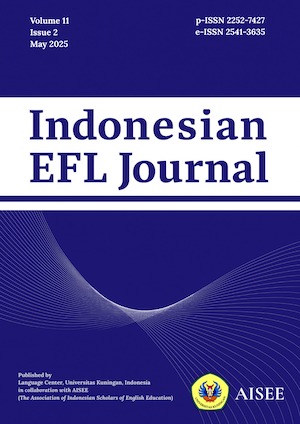EXPLORING LOW AND HIGH STUDENTS’ PERCEPTION ON ENGAGING E-DICTIONARY IN MASTERING VOCABULARY: CROSS-SECTIONAL SURVEY
Abstract
This paper is a survey study that aims at investigating low and high achievement students’ perception on engaging electronic dictionary in enhancing their vocabulary mastery. There were 30 students involved in this study consisting of 16 students as the high achievement students and 14 students as the low achievement students. They were considered as high and low students based on the result of their last examination score. Questionnaire and interview were used to collect the data. The results of the study showed that low achievement students have positive perception on the use of electronic dictionary especially Google Translate. Most of them agreed that the use of Google Translate helped them in improving their English vocabulary mastery because Google Translate is easy to use and fast in translating meaning of words. Moreover, most of the high achievement students also have positive perception on the use of Google Translate because it is easy to use and free, it can be accessed by using their smartphones. Nevertheless, the problems also found in the use of electronic dictionary especially Google Translate, including bad internet connection which affected the performance of Google Translate. It can be conluded that there are almost similar perception between low and high achievement students on the use of electronic dictionary especially Google Translate.
Keywords: electronic dictionary; google translate; low and high achievement students; perception; vocabulary mastery.
References
Cameron, L. (2001). Teaching languages to young learners. Cambridge: Cambridge University Press.
Creswell, W, J. (2012). Educational research planning, conducting, and evaluating quantitative and qualitative research (4th ed.). London: Pearson Education.
Dornyei, Z. (2003). Questionnaires in second language construction, administration, and processing. London: Lawrence Erlbaum Associates.
Fink, A. (2003). The survey handbook (2nd ed.). Sage: Sage Publication Inc.
Hatch, E., & Lazaraton, A. (1991). The research manual design and statistics for applied linguistics. Boston: Heinle & Heinle Pub.
Murnani, Z. T., & Salehi, H. (2015). Effect of electronic dictionary as an ICT tool. English Collocation Learning of EFL Learners, 3(5), 366–373.
Rezaei, M., & Davoudi, M. (2016). The influence of electronic dictionaries on vocabulary. Knowledge Extension, 5(3), 139–148. doi: 10.5539/jel.v5n3p139.
Robbins, P, S., & Judge, A, T. (2013). Organizational behavior (15th ed.). London: Pearson Education.
Thornbury, S. (2002). How to teach vocabulary. London: Pearson Education.









